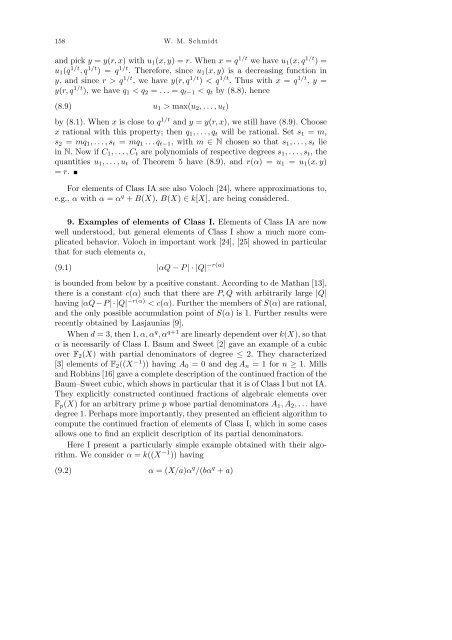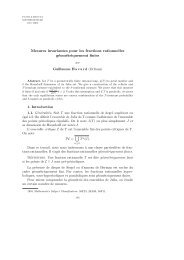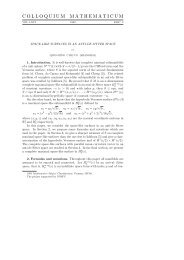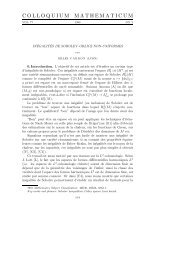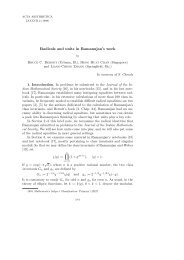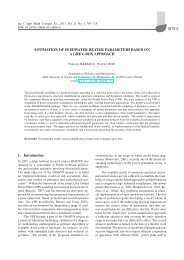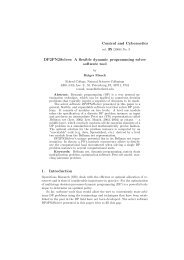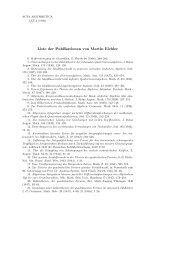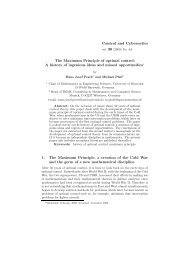On continued fractions and diophantine approximation in power ...
On continued fractions and diophantine approximation in power ...
On continued fractions and diophantine approximation in power ...
You also want an ePaper? Increase the reach of your titles
YUMPU automatically turns print PDFs into web optimized ePapers that Google loves.
158 W. M. Schmidt<br />
<strong>and</strong> pick y = y(r, x) with u1(x, y) = r. When x = q 1/t we have u1(x, q 1/t ) =<br />
u1(q 1/t , q 1/t ) = q 1/t . Therefore, s<strong>in</strong>ce u1(x, y) is a decreas<strong>in</strong>g function <strong>in</strong><br />
y, <strong>and</strong> s<strong>in</strong>ce r > q 1/t , we have y(r, q 1/t ) < q 1/t . Thus with x = q 1/t , y =<br />
y(r, q 1/t ), we have q1 < q2 = . . . = qt−1 < qt by (8.8), hence<br />
(8.9) u1 > max(u2, . . . , ut)<br />
by (8.1). When x is close to q 1/t <strong>and</strong> y = y(r, x), we still have (8.9). Choose<br />
x rational with this property; then q1, . . . , qt will be rational. Set s1 = m,<br />
s2 = mq1, . . . , st = mq1 . . . qt−1, with m ∈ N chosen so that s1, . . . , st lie<br />
<strong>in</strong> N. Now if C1, . . . , Ct are polynomials of respective degrees s1, . . . , st, the<br />
quantities u1, . . . , ut of Theorem 5 have (8.9), <strong>and</strong> r(α) = u1 = u1(x, y)<br />
= r.<br />
For elements of Class IA see also Voloch [24], where <strong>approximation</strong>s to,<br />
e.g., α with α = α q + B(X), B(X) ∈ k[X], are be<strong>in</strong>g considered.<br />
9. Examples of elements of Class I. Elements of Class IA are now<br />
well understood, but general elements of Class I show a much more complicated<br />
behavior. Voloch <strong>in</strong> important work [24], [25] showed <strong>in</strong> particular<br />
that for such elements α,<br />
(9.1) |αQ − P | · |Q| −r(α)<br />
is bounded from below by a positive constant. Accord<strong>in</strong>g to de Mathan [13],<br />
there is a constant c(α) such that there are P, Q with arbitrarily large |Q|<br />
hav<strong>in</strong>g |αQ−P |·|Q| −r(α) < c(α). Further the members of S(α) are rational,<br />
<strong>and</strong> the only possible accumulation po<strong>in</strong>t of S(α) is 1. Further results were<br />
recently obta<strong>in</strong>ed by Lasjaunias [9].<br />
When d = 3, then 1, α, α q , α q+1 are l<strong>in</strong>early dependent over k(X), so that<br />
α is necessarily of Class I. Baum <strong>and</strong> Sweet [2] gave an example of a cubic<br />
over F2(X) with partial denom<strong>in</strong>ators of degree ≤ 2. They characterized<br />
[3] elements of F2((X −1 )) hav<strong>in</strong>g A0 = 0 <strong>and</strong> deg An = 1 for n ≥ 1. Mills<br />
<strong>and</strong> Robb<strong>in</strong>s [16] gave a complete description of the <strong>cont<strong>in</strong>ued</strong> fraction of the<br />
Baum–Sweet cubic, which shows <strong>in</strong> particular that it is of Class I but not IA.<br />
They explicitly constructed <strong>cont<strong>in</strong>ued</strong> <strong>fractions</strong> of algebraic elements over<br />
Fp(X) for an arbitrary prime p whose partial denom<strong>in</strong>ators A1, A2, . . . have<br />
degree 1. Perhaps more importantly, they presented an efficient algorithm to<br />
compute the <strong>cont<strong>in</strong>ued</strong> fraction of elements of Class I, which <strong>in</strong> some cases<br />
allows one to f<strong>in</strong>d an explicit description of its partial denom<strong>in</strong>ators.<br />
Here I present a particularly simple example obta<strong>in</strong>ed with their algorithm.<br />
We consider α = k((X −1 )) hav<strong>in</strong>g<br />
(9.2) α = (X/a)α q /(bα q + a)


